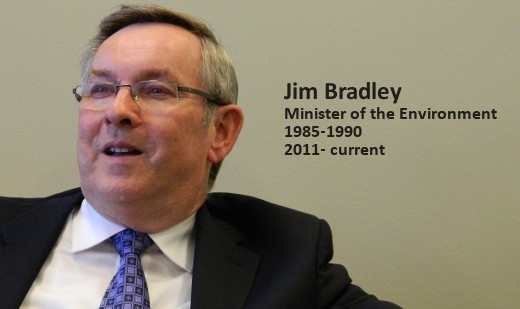By 1985, Ontarians were concerned about environmental issues that they had barely known about a decade earlier - acid rain, toxic chemicals in the water, industrial and sewage discharges and many more. Here, Jim Bradley and some his staff discuss how some problems were resolved.
When Jim Bradley became Ontario's Minister of the Environment in 1985, after seven years as an opposition Member of Provincial Parliament, a lot of people were surprised that he wanted that particular job, which had been a minor cabinet post until then. Environmentalists and many Ontarians were surprised when he brought so many changes to environmental protection so quickly, and Bradley himself was surprised at how much he needed to do in a short time.
By 1985, people around the world had learned a lot about threats to the environment. In Ontario, the public was concerned about emerging issues that they had barely known about a decade earlier - acid rain, toxic chemicals in the water, industrial and sewage discharges and what seemed to be never-ending excuses from polluters.
When Bradley took office, it was more than a decade after groups like Greenpeace and Pollution Probe were established and 15 years after the first Earth Day. Ontarians were ready for more action on the environment.
Building a team for the environment
Sometimes new premiers' offices assign staff to ministers. but Bradley's boss, Premier David Peterson, gave the new environment minister wide latitude to take action, and allowed him to build his team. Bradley recruited Mark Rudolph (who was working with the federal environment minister at the time) as his Chief of Staff, and Gary Gallon as his Senior Policy Advisor. Gallon, who passed away in 2003, was a former Ontario Liberal researcher with deep roots in the environmental movement who had served on the first Greenpeace Board of Directors. He brought in David Oved (a former Queen's Park reporter) as his Press Secretary. Later, he hired Sarah Rang as a Policy Advisor.
Bradley and his team proceeded to shake up environmental politics and policy in Ontario as never had been done before. It seemed as though every month, everywhere, there was a new environmental battle to be fought. The issues became top news, highlighted on the front pages of the Toronto Star, the Globe and Mail, and other media outlets across the province. As Bradley notes there was no
Environmental Commissioner of Ontario's office in the 1980s, so it was important for activists to raise awareness of environmental issues through the media.
One of the first actions from Bradley's team was to proclaim Ontario's Spills Bill, a law governing chemical spills that had been passed by the previous government but never proclaimed (a law must be proclaimed for it to take effect).
Industries, truckers and farmers didn't like this law. Under the bill, when there was a spill, the onus was on the spiller to protect the environment by cleaning it up first -- and determining ultimate legal liability later.
Bradley worked with experts in the insurance industry to prompt establishment of a spills liability insurance "facility" - a pool of funds, contributed by industry, to pay for cleaning up spills.
Bradley's Environmental Battles
Even within the government there were environmental struggles to contend with.
As Environment Minister, Bradley fought internally to stop plans by the Ministry of Transportation to build a highway through
Rouge River Valley (where Canada's first urban national park is now being created). He took on Ontario Hydro's resistance to controlling acid rain pollution caused by its coal-fired power plants. (Coal is now being phased out at power plants across Ontario.)
Bradley also discovered that there were pollution problems creeping up along waterways and borders all around and through Ontario. In the St. Clair River, a "blob" of cancer-linked dioxin was discovered just offshore from the Dow Chemical Company in Sarnia. In many cases, companies had received permission from local Ministry of the Environment officials to discharge chemicals into the water. In some cases they did it without permission, and officials did little to enforce the rules. To put an end to these kinds of loose water pollution practices, Bradley cracked down with much tougher pollution control orders and set up the ministry's own environmental police force (now part of the Ministry of the Environment's Operations Division). Eventually, Bradley brought in a province-wide regulatory system (
"Municipal/Industrial Strategy for Abatement") that set limits on every company that discharges into waterways.
Bradley was also responsible for the introduction of the
Blue Box recycling program, and for banning notoriously dirty-burning apartment building incinerators - up until the 1980s, apartment residents dumped their garbage down incinerator chutes and there was virtually no control over what chemicals came out from those apartment chimneys.
Some of the most exciting and important advances in environmental protection in this period took place across provincial and international borders. Bradley met friends and foes alike in Congress and statehouses on cross-border issues such as acid rain and the Great Lakes, and he worked extensively with our federal government and his counterparts in Quebec, Manitoba and Atlantic and Western Canada.
During Bradley's term as Minister of the Environment in the 1980s (he was appointed again as Minister in 2011), issues that have taken centre stage today were just beginning to emerge. For example, climate change was just beginning to raise concerns (the first international conference on the subject was held in Toronto in 1988). Bradley, along with Oved, Rang, Rudolph and Gallon, left a legacy for environmental change.

